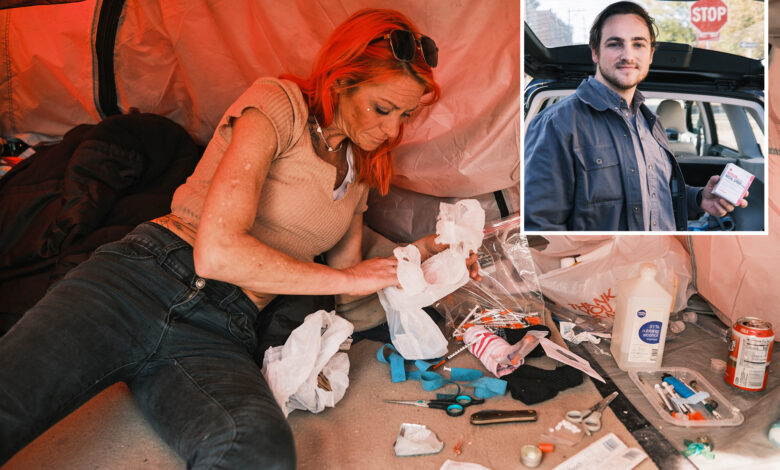Philadelphia man Ryan Sager a ‘superhero’ for saving lives with Narcan

Amongst the wasteland of one of America’s most drug-addled neighborhoods, one man has made it his mission to save addicts dying from overdoses.
Ryan Sager, 27, has been dubbed the closest thing to a real-life superhero and the “Narcan Batman” by friends for his work, monitoring the streets of Kensington in his spare time for the last three years.
He spends hours driving through the area, which has become the largest open-air drug market on the East Coast, full of rampant and open drug use, dealing and homelessness.
Sager doesn’t drive a Batmobile or wear a cape. Instead, he cruises the streets largely undetected in a 1997 blue Subaru Forester.
His self-appointed mission is to find anyone who has overdosed, swoop in and save them by administering a Narcan inhaler which rapidly reverses the effects of opioids.
“When you see someone [and] their chest isn’t rising, that’s an indicator for me. I’ll stop, I’ll yell at them,” Sager says.
“If they don’t respond, I’ll get out and yell at them again.
“If they still don’t respond I’ll approach them and if I can see their chest is definitely not rising, that’s when I’m going to Narcan them.
“That person can be up and responsive before an ambulance arrives so those precious minutes of not breathing are really reduced and that can make all the difference.”
During his time on patrol Sager says he’s saved at least four lives by reversing overdoses. Albeit, a drop in the bucket of the 1,413 unintentional overdose deaths the Philadelphia Department of Public Health recorded in 2022.
The Post joined him on a crisp, sunny Sunday morning earlier in November. Several hundred drug-addicts in various states of disarray were visible on the suburb’s notorious Kensington Avenue and nearby “Needle Park”.
The hordes congregate along the strip and freely shoot up drugs at all times of the day and night. Around 11am, one woman sat on a chair on the edge of the sidewalk and raised an arm as another woman crouched down below her and injected her armpit. Cars whizz straight by.
A few meters away a man held a small mirror up to his face in one hand, and used the other to push a needle into his neck. Blood trickled down onto his chest and under his bright red sweater as he let go of the syringe, leaving it dangling from him.
Dozens of bystanders appeared completely unfazed by the chaotic and disturbing scene, most focused on sticking needles into their own bodies and getting high, even if just to prevent themselves from going into withdrawal and becoming violently ill.
This is a normal Sunday.
Some addicts were stood on sidewalks and roads, slowly swaying while bent over so far they are almost touched their toes.
Others sprawled out on the ground or slumped against the walls of buildings.
“I usually do a few laps of the area and the streets where I know people will be,” Sager explained.
Fortunately, no one appeared to be in respiratory failure, so Sager expanded his search down some of Kensington’s side streets and laneways frequented by addicts.
The train lines and nearby Interstate 95 freeway bring in customers from all over the region, including the suburbs of Philadelphia, Delaware and New Jersey.
Philadelphia’s opioid crisis has become a significant public health concern, exacerbated by the rise of Xylazine – or “tranq” – a powerful horse and cattle sedative used to enhance the effects of heroin, cocaine and fentanyl – which was found in over 90% of drug samples tested in the city in 2021, according to city data.
At one encampment on the fringe of a road by a bridge, about a dozen addicts were shooting up around midday, when Sager pulled up to check on them.
They were surrounded by used toilet paper, syringes and other bits of junk.
“Is everyone OK?” Sager asks.
One man explains they’re doing well because they’re all stocked up on drugs and have clean needles.
Sager offered them some Narcan and moved to the other end of the squalid camp to check in on others.
“Stick it in,” self-professed drug addict Brittany Harrison, 38, told her husband Brian Harrison, who was preparing to inject her in the groin with opioids mixed with tranq.
They’re sitting in an open two-man tent – where they’ve lived for the past few months and are preparing for a very harsh winter without adequate heating or shelter.
“If I don’t inject her someone else will,” Brian told The Post as he rubbed his wife’s back.
“And at least if it’s me I can help if she overdoses.
“Someone else might not do that.”
According to them, they’ve both been “Narcan-ed” dozens of times over the years.
“If I had to guess, I’ve been Narcan-ed 15-20 times since 1995,” Brian says.
“The ambulance has done it a couple of times. My wife has done it quite a few times.”
Brittany told The Post she would be dead if she hadn’t been found and given Narcan during one particularly bad overdose.
Like most of the addicts in Kensington, the couple say they were drawn to the town “for the drugs”, and both admitted they’ve descended further into addiction and despair since their time living there.
“I’ve never been this down and out,” Brittany says.
“I’ve never not had a home, never not had a car. I used to have a full time job.
“I feel like once you’re in Kensington you’re kind of like cut off from the world.
“Like, I don’t know what time it is. I don’t know what day it is. I know nothing about what’s going on outside.
“I know as long as we’re doing this, we’re stuck.”
Brittany said she “does dates” — code for sex work — to fund both her and Brian’s habits.
“I hate it. It’s disgusting,” she says.
“I’ve been raped twice. I’ve been jumped twice. I’ve been left places where I’ve had to walk really far to get back here. I’ve had so much bad s–t happen to me here it’s sad.”
The mother-of-four grew up “in a family where no one does drugs” and said she just fell in with the wrong crowd as a teenager and has been battling severe addiction ever since.
“I want my family back and my life back and to stop doing drugs but I don’t know how to get there,” she says.
Pennsylvania was among the top 10 states with the highest overdose death rates in 2021, according to the Centers for Disease Control and Prevention.
Drug overdose mortality hit a record-high of 5,449 deaths across the state, up nearly 25% since 2019.
The majority of the time, Sager finds the addicts he approaches are not in need of Narcan, so he gives out the inhalers for them to have on hand for future use. Some people, including one man hunched over between a gutter and a garden in a fast food parking lot, decline the offer.
The medication is non-addictive and has no effect on anyone who is not actively overdosing.
In an alley a few blocks away, Phil Kravitz, 55, sat on a gutter and scraped his arm with a needle.
“I’m an opiate addict,” he told The Post, adding he’s been battling addiction for 35 years.
“I’ve been hit with Narcan when I’ve overdosed… I’ve lost count how many times.
“I try to keep my doses to a minimum because it’s dangerous s—t.
“I see people overdose here every day.”
Kravitz’s skin is covered in open wounds caused by tranq, commonplace amongst those who live in Kensington.
“I was hospitalized three times for this s**t,” he says.
“I used to have big, gaping, holes with puss and abscesses in my arms. I nearly died that time. I felt like I wasn’t going to make it that time. But I did.”
People who inject drug mixtures laced with tranq can also develop severe wounds, including necrosis — the rotting of flesh — that may lead to amputation, according to the Drug Enforcement Administration.
Several of Kravitz’s friends are slumped against a rock wall with their eyes closed and their mouths open. The visible parts of their bodies show signs of rotting skin. It’s hard to tell if they’re dead or alive.
Sager gently asks Kravitz if the men who appear to be passed out are OK.
“Yeah they’re all good,” he says, as one of them briefly opens his eyes and Sager leaves a box of Narcan with the group.
Narcan is available in different forms, including nasal inhalers, making it easy to administer even by non-medical professionals.
It works by binding to the opioid receptors in the brain, displacing the opioids and reversing their effects, and quickly restoring normal breathing to individuals experiencing an overdose.
The person who is overdosing doesn’t need to inhale the medication for it to work as it is absorbed simply by spraying it into the nostrils.
Many addicts deep in their addiction don’t want to be given the medication because it ruins their high and sends them into withdrawal.
Joshua Hartman, a 35-year-old drug addict living on the streets of Kensington, told The Post he’d rather die than “be Narcan-ed”.
For this reason, Sager usually calls an ambulance as a precaution then makes a swift exit once the person he’s revived starts coming to.
“Luckily, it takes about five minutes for them to fully wake up from the moment they’ve inhaled it, so I usually just get out of there before they’re able to realize what’s happened,” he says.
“In every instance but one where I have decided to Narcan someone they have been breathing and responsive before the ambulance got there.”
Fortunately for Sager, he is not driven by praise, but simply wants to stop preventable deaths.
However, the catalyst for him becoming the “Narcan Batman” was a tragedy.
Sager says he was called to help a neighbor and a friend in his building after she overdosed and paramedics had not yet arrived.
Sadly, the 41-year-old woman died. Sager has never quite forgiven himself because he believes her death could have been prevented if only he had the right training and access to Narcan at the time.
“She died from a drug overdose right in-front of me,” he tells The Post.
“When the paramedics got there they did CPR and were able to restart her heart.
“But she’d gone without oxygen for 20 minutes and she was already brain dead so it was too late for them to save her.
“The issue that I’m subconsciously trying to rectify is when she passed away I was there and I could have done something but I wasn’t able to.”
Sager said he is repeatedly told by others to “just let the junkies take care of themselves and die” but that’s not a notion he subscribes to.
“It’s very likely these people I revive will overdose again,” Sager says.
“We’ve talked to a bunch of people who said they’ve been Narcan-ed 15 times.
“But no one knows when that turning point is going to happen.
“What Narcan can do is give that person a second, third or fiftieth chance. It doesn’t matter how many chances they need – as long as everyone gets that opportunity.”
Sager says that’s a mindset his grandfather instilled in him from a young age.
“My pop pop used to always tell me that ‘the only obligation you have to help somebody is that you can’,” he adds.
“And that’s what I try to live by.”




